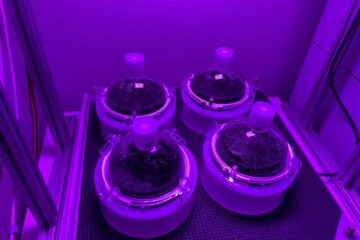Carbon Sink or Carbon Source? Aerosols Play Significant Role in Shifts

Researchers at North Carolina State University have shown that the amount of aerosols – dust particles, soot from automobile emissions and factories, and other airborne particles – in the atmosphere has a significant impact on whether the surface area below either absorbs or emits more carbon dioxide (CO2).
The researchers discovered that changes in the levels of airborne aerosols resulted in changes to the terrestrial carbon cycle, or the cycle in which CO2 is absorbed by plant photosynthesis and then emitted by the soil.
Besides documenting the effects of aerosols on the carbon cycle, the research also showed that the type of landscape also influenced whether a surface area served as a carbon sink, an area that absorbs more CO2 than it emits, or as a carbon source, an area that emits more CO2 than it absorbs. In the research project, six locations across the United States – encompassing forests, croplands and grasslands – were studied. Increased amounts of aerosols over forests and croplands resulted in surface areas below becoming carbon sinks, but increased amounts of aerosols over grasslands resulted in surface areas becoming carbon sources.
Dr. Dev Niyogi, research assistant professor of marine, earth and atmospheric sciences at NC State and lead author of the study, hypothesizes that the differences among landscapes can be attributed to the amount of shade provided by tree and plant leaves in forests and croplands. The lack of shading in grasslands changes the ground surface temperature, which alters the rate of photosynthesis in plants and the CO2 emissions by soil. Since plants want to take in CO2 but also preserve water at the same time, Niyogi believes the lack of shade and increased temperatures may cause plants to slow the rate of photosynthesis, causing less CO2 to be absorbed and thus more CO2 to be effectively emitted. That would make the surface area a carbon source.
The research was published in Geophysical Research Letters, a journal of the American Geophysical Union. Niyogi’s co-authors on the research paper include NC State graduate student Hsin-I Chang; Dr. Vinod Saxena, professor of marine, earth and atmospheric sciences at NC State; Dr. Randy Wells, professor of crop science at NC State; Dr. Fitzgerald Booker, associate professor of crop science at NC State and USDA-ARS plant physiologist; Dr. Teddy Holt, adjunct professor of marine, earth and atmospheric sciences at NC State and a scientist at Naval Research Laboratory-Monterey; and colleagues from across the country.
Aerosols have been known to affect the climate by changing the radiation that reaches the earth surface. Increase in aerosols is often considered one possible reason that the earth’s surface has not seen as much warming as previously projected by climate models.
Previous studies have shown that many factors affect the carbon cycle, including rainfall and changes in land cover. But this study is believed to be the first multisite, observational analysis demonstrating that aerosols affect the carbon cycle. The study shows aerosols affect the earth’s regional climate in an even more profound manner by affecting its biological and chemical exchanges of the greenhouse gases.
The study examined six sites across the United States in the summertime; these locations were chosen because data on aerosols and carbon fluxes, or the changes in the carbon absorption and emission rates, were readily available. Sites ranged from grassland in Alaska to mixed forestland in Wisconsin to cropland in Oklahoma.
Before showing the effects of aerosols on the carbon cycle, the paper first showed the effects of diffuse radiation – radiation that is not direct sunlight but radiation scattered by clouds, haze, or something else – on carbon fluxes. The research showed that higher levels of diffuse radiation resulted in higher rates of carbon sink.
Although common sense would suggest that areas with plants receiving more constant direct sunlight would result in a surface becoming a carbon sink, that is not necessarily the case, Niyogi says. In fact, more radiation means plants more quickly reach a level of photosaturation. As Niyogi explains it, “Plants absorb CO2 very efficiently. At very high levels of radiation, as is the case with direct radiation, additional increases do not necessarily cause increased photosynthesis. It doesn’t matter how much more radiation you add, the plant is not going to absorb more CO2. But at lower levels of radiation, as is the case with diffuse radiation, any increase in radiation translates to additional photosynthesis.”
The study then examined the effects of cloudiness on the carbon cycle. Cloudiness, which increased the amount of diffuse radiation, resulted in a greater amount of carbon sink in surface areas.
The study team then linked aerosols and diffuse radiation, and showed strong relationships between high amounts of aerosols and high amounts of diffuse radiation and between low amounts of aerosols and low amounts of diffuse radiation.
Finally, the study yielded its most important findings: Aerosols affect the carbon cycle in different types of landscapes, with forests and croplands serving as carbon sinks while grasslands served as carbon sources.
“When you have more carbon being absorbed, it means that plants and forests there are going to grow faster,” Niyogi said. “And so it has the potential to alter the landscape. And when you have a change in landscape, or a change in the biogeochemical properties – like the carbon cycle – you have a landscape that is actively vulnerable to climate change.
“Studies like these can really start putting forward the right processes in trying to quantify the carbon sink more accurately. Once we start introducing these reality-based processes into our models, we’ll get better estimates” of carbon budget, Niyogi said.
Niyogi now plans to add other variables to studying the carbon cycle, such as the effects of different types of aerosols, and factors like soil moisture. He is also planning regional and global analyses – using satellite remote sensing and models – to see if results square with the field studies.
The research was funded by NASA, the National Science Foundation, the Office of Naval Research, and an NC State Faculty Research and Professional Development Award.
Media Contact
More Information:
http://www.ncsu.eduAll latest news from the category: Ecology, The Environment and Conservation
This complex theme deals primarily with interactions between organisms and the environmental factors that impact them, but to a greater extent between individual inanimate environmental factors.
innovations-report offers informative reports and articles on topics such as climate protection, landscape conservation, ecological systems, wildlife and nature parks and ecosystem efficiency and balance.
Newest articles

How blue-green algae manipulate microorganisms
Research team at the University of Freiburg discovers previously unknown gene that indirectly promotes photosynthesis. Cyanobacteria – also called blue-green algae – are known as the “plants of the ocean”…

Combatting disruptive ‘noise’ in quantum communication
In a significant milestone for quantum communication technology, an experiment has demonstrated how networks can be leveraged to combat disruptive ‘noise’ in quantum communications. The international effort led by researchers…

Stretchable quantum dot display
Intrinsically stretchable quantum dot-based light-emitting diodes achieved record-breaking performance. A team of South Korean scientists led by Professor KIM Dae-Hyeong of the Center for Nanoparticle Research within the Institute for…





















